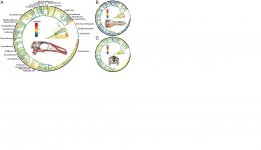Fred Ruhe
Well-known member

Ryan N. Felice, Akinobu Watanabe, Andrew R. Cuff, Michael Hanson, Bhart-Anjan S. Bhullar, Emily R. Rayfield, Lawrence M. Witmer, Mark A. Norell & Anjali Goswam, 2020
Decelerated dinosaur skull evolution with the origin of birds
PLoS Biology 18(8): e3000801
doi: https://doi.org/10.1371/journal.pbio.3000801
https://journals.plos.org/plosbiology/article?id=10.1371/journal.pbio.3000801
Free pdf:
https://journals.plos.org/plosbiology/article/file?id=10.1371/journal.pbio.3000801&type=printable
Abstract:
The evolutionary radiation of birds has produced incredible morphological variation, including a huge range of skull form and function. Investigating how this variation arose with respect to non-avian dinosaurs is key to understanding how birds achieved their remarkable success after the Cretaceous–Paleogene extinction event. Using a high-dimensional geometric morphometric approach, we quantified the shape of the skull in unprecedented detail across 354 extant and 37 extinct avian and non-avian dinosaurs. Comparative analyses reveal fundamental differences in how skull shape evolved in birds and non-avian dinosaurs. We find that the overall skull shape evolved faster in non-avian dinosaurs than in birds across all regions of the cranium. In birds, the anterior rostrum is the most rapidly evolving skull region, whereas more posterior regions—such as the parietal, squamosal, and quadrate—exhibited high rates in non-avian dinosaurs. These fast-evolving elements in dinosaurs are strongly associated with feeding biomechanics, forming the jaw joint and supporting the jaw adductor muscles. Rapid pulses of skull evolution coincide with changes to food acquisition strategies and diets, as well as the proliferation of bony skull ornaments In contrast to the appendicular skeleton, which has been shown to evolve more rapidly in birds, avian cranial morphology is characterised by a striking deceleration in morphological evolution relative to non-avian dinosaurs. These results may be due to the reorganisation of skull structure in birds—including loss of a separate postorbital bone in adults and the emergence of new trade-offs with development and neurosensory demands. Taken together, the remarkable cranial shape diversity in birds was not a product of accelerated evolution from their non-avian relatives, despite their frequent portrayal as an icon of adaptive radiations.
Enjoy,
Fred
Decelerated dinosaur skull evolution with the origin of birds
PLoS Biology 18(8): e3000801
doi: https://doi.org/10.1371/journal.pbio.3000801
https://journals.plos.org/plosbiology/article?id=10.1371/journal.pbio.3000801
Free pdf:
https://journals.plos.org/plosbiology/article/file?id=10.1371/journal.pbio.3000801&type=printable
Abstract:
The evolutionary radiation of birds has produced incredible morphological variation, including a huge range of skull form and function. Investigating how this variation arose with respect to non-avian dinosaurs is key to understanding how birds achieved their remarkable success after the Cretaceous–Paleogene extinction event. Using a high-dimensional geometric morphometric approach, we quantified the shape of the skull in unprecedented detail across 354 extant and 37 extinct avian and non-avian dinosaurs. Comparative analyses reveal fundamental differences in how skull shape evolved in birds and non-avian dinosaurs. We find that the overall skull shape evolved faster in non-avian dinosaurs than in birds across all regions of the cranium. In birds, the anterior rostrum is the most rapidly evolving skull region, whereas more posterior regions—such as the parietal, squamosal, and quadrate—exhibited high rates in non-avian dinosaurs. These fast-evolving elements in dinosaurs are strongly associated with feeding biomechanics, forming the jaw joint and supporting the jaw adductor muscles. Rapid pulses of skull evolution coincide with changes to food acquisition strategies and diets, as well as the proliferation of bony skull ornaments In contrast to the appendicular skeleton, which has been shown to evolve more rapidly in birds, avian cranial morphology is characterised by a striking deceleration in morphological evolution relative to non-avian dinosaurs. These results may be due to the reorganisation of skull structure in birds—including loss of a separate postorbital bone in adults and the emergence of new trade-offs with development and neurosensory demands. Taken together, the remarkable cranial shape diversity in birds was not a product of accelerated evolution from their non-avian relatives, despite their frequent portrayal as an icon of adaptive radiations.
Enjoy,
Fred




